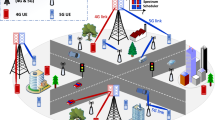Abstract
The heterogeneous cooperative relaying technique can be utilized to complete the hierarchical convergence for the multi-radio access networks, where the single heterogeneous cooperative relay is selected and the maximal-ratio combining (MRC) scheme is utilized to achieve the cooperative diversity gain. In order to evaluate performances of the hierarchical convergence mechanism, this paper theoretically investigates the key factors of the multi-user diversity (MUD) gain, the heterogeneous cooperative diversity gain and the large scale fading of the first and second links. The tight closed-form expressions in terms of the outage probability and the average symbol error rate are derived for evaluating how and with what factors impact on the system performance. The analytical and simulation results show that the number of heterogeneous cooperative relay nodes (HCRNs)M and the number of destination stations (DSs)K have great impacts on performances, and the order of outage probability is (M + 1)K. The large scale fading ratio of the first hop to the second hop also has a big impact on performances. Thus in the real network, we can utilize advanced radio resource management schemes to achieve a high multi-user diversity, instead of configuring too many HCRNs for the heterogeneous cooperative diversity gain. Furthermore, we can guarantee the transmission quality between the BS and HCRNs via the network planning to optimize the overall network performance.








Similar content being viewed by others
References
Ahmavaara, K., Haverinen, H., & Pichna, R. (2003). Interworking architecture between 3GPP and WLAN systems. Communications Magazine, IEEE, 41(11), 74–81.
Lampropoulos, G., Salkintzis, A. K., & Passas, N. (2008). Media-independent handover for seamless service provision in heterogeneous networks. Communications Magazine, IEEE, 46(1), 64–71.
Peng, M., Zhang, Q., & Wenbo, W. (2008). A utility-based capacity optimization framework for achieving cooperative diversity in the hierarchical converged heterogeneous wireless networks. International Journal of Communication Systems, 21(12), 1285–1306.
Yamada, M., Shinkuma, R., & Takahashi, T. (2006). Cooperative networking in heterogeneous infrastructure multihop mobile networks. Personal, Indoor and Mobile Radio Communications, 2006 IEEE 17th International Symposium on. Sept., pp. 1–5
Chen, C.-J., & Wang, L.-C. (2006). A unified capacity analysis for wireless systems with joint multi-user scheduling and antenna diversity in Nakagami fading channels. IEEE Transactions on Communication, 54(3), 469–478.
Chen, Z., Yuan, J., & Vucetic, B. (2005). Analysis of transmit antenna selection /maximal-ratio combining in Rayleigh fading channels. IEEE Transactions on Vehicle Technology, 54(4), 1312–1321.
Choi, S., Ko, Y.-C., & Powers E.J. (2005). Performance analysis of maximal-ratio combining with transmit antenna selection for generalized selection criterion. in Proc. of VTC’05 fall 3, pp. 2039–2042.
Sharma, N., & Ozarow, L. H. (2005). OA study of opportunism for multiple-antenna systems. IEEE Transactions on Information Theory,51(5), 1804–1814.
Lau, V. K. N. (2005). Proportional fair space-time scheduling for wireless communications. IEEE Transactions on Communication, 53(8), Aug.
Zhang, X., Lv, Z., & Wang, W. (2008). Performance analysis of multiuser diversity in MIMO systems with antenna selection. IEEE Transactions on Wireless Communications, 7(1), 15–21.
Bender, P., Black, P., Grob, M., Padovani, R., Sindhushayana, N., & Viterbi, A. (2000). CDMA/HDR: A bandwidth-efficient high-speed wireless data service for nomadic users. IEEE Communications Magazine, 38(7), 70-77.
Holtzman, J. M. (2001). Asymptotic analysis of proportional fair algorithm. in Proc. IEEE PIMRC 2, F33–F37.
Chen, C.-J., & Wang, L.-C. (2006). A unified capacity analysis for wireless systems with joint multi-user scheduling and antenna diversity in Nakagami fading channels. IEEE Transactions on Communication, 54(3), 469–478.
Gastpar, M., Vetterli, M. (2005). On the capacity of large gaussian relay networks. IEEE Transactions on Information Theory, 51(3), 765–779.
Morgenshtern, V. I., & Bocskei, H. (2007). Crystallization in large wireless networks. IIEEE Transactions on Information Theory, 53(10), 3319–3349.
Bletsas, A., Shin, H., & Win, M. Z. (2007). Cooperative communications with outage-optimal opportunistic relaying. IEEE Transactions on Information Theory, 6(9), 1–11.
Chen, Z., Yuan, J., & Vucetic, B. (2005). Analysis of transmit antenna selection/maximal-ratio combining in Rayleigh fading channels. IEEE Transactions on Vehicle Technology, 54(4), 1312–1321.
David, H. A. (1981). Order statistics (2nd Ed.). New York: Wiley.
Proakis, J. G. (2001). Digital communications (4th Ed.). New York: McGraw-Hill.
Acknowledgments
This work is supported in part by the National Natural Science Foundation of China under No. 60602058, and supported in part by the national advanced technologies researching and developing programs. (China 863 programming, NO.: 2009AA01Z244).
Author information
Authors and Affiliations
Corresponding author
Rights and permissions
About this article
Cite this article
Peng, M., Wang, W. & Zhang, J. Performance analysis of multi-user diversity in heterogeneous cooperative communication systems. Wireless Netw 16, 1903–1912 (2010). https://doi.org/10.1007/s11276-009-0234-6
Published:
Issue Date:
DOI: https://doi.org/10.1007/s11276-009-0234-6




